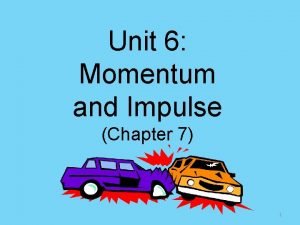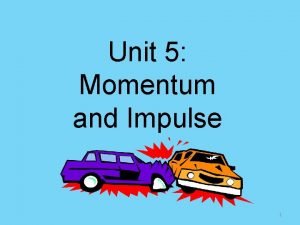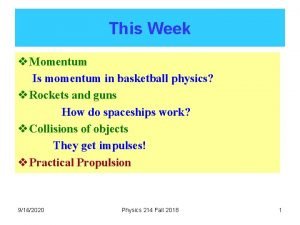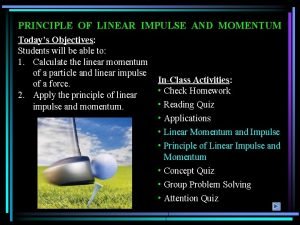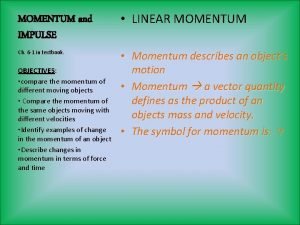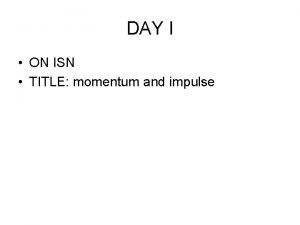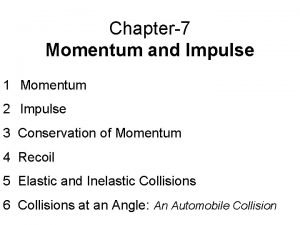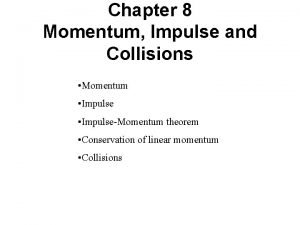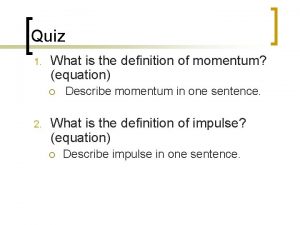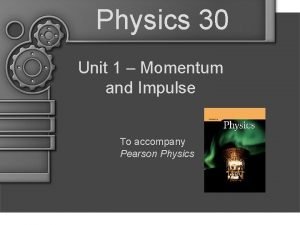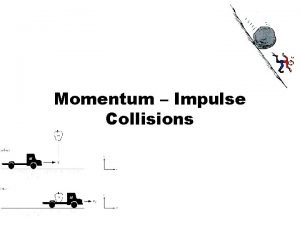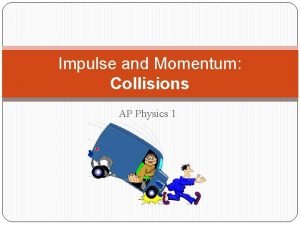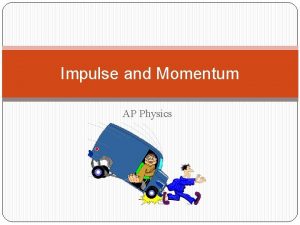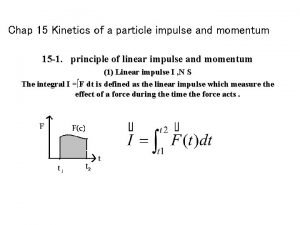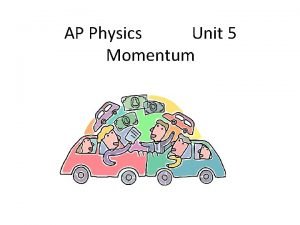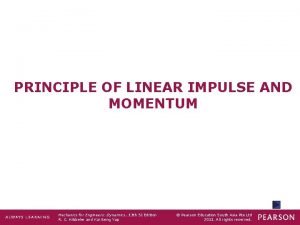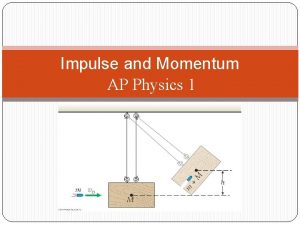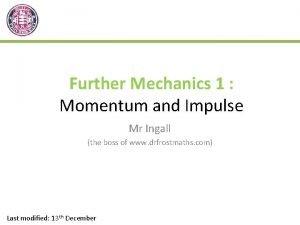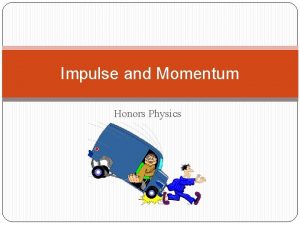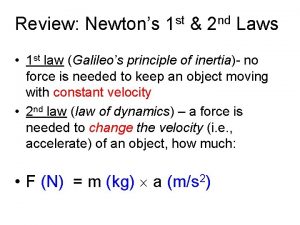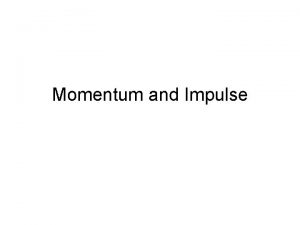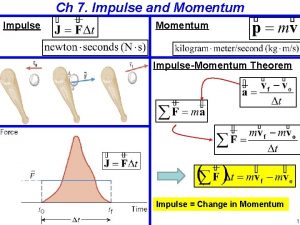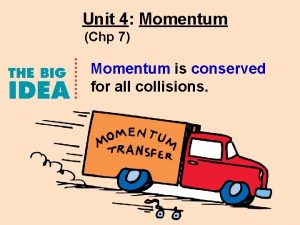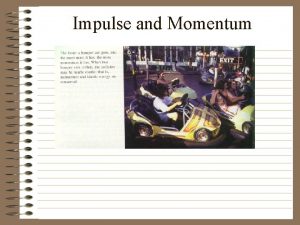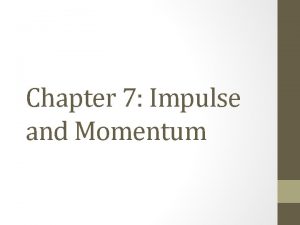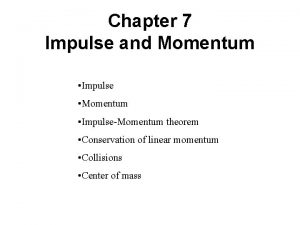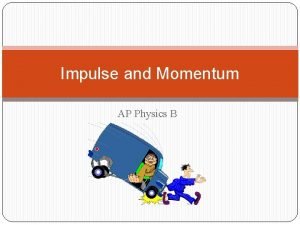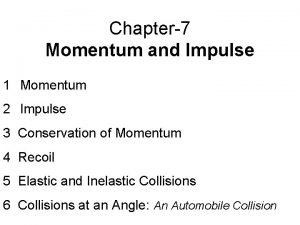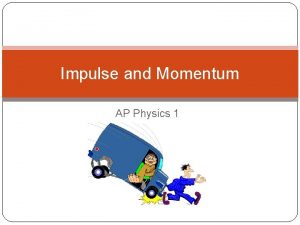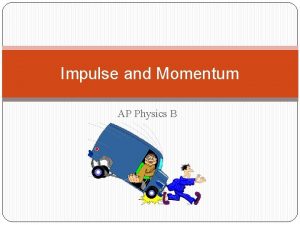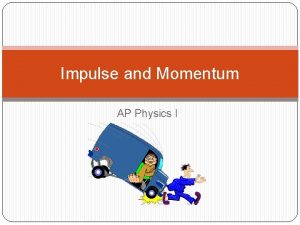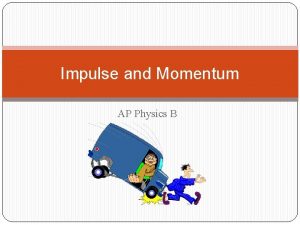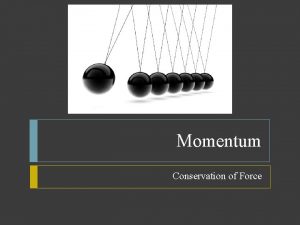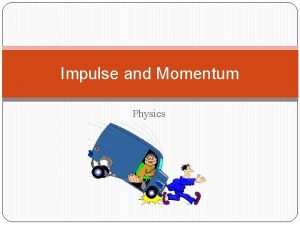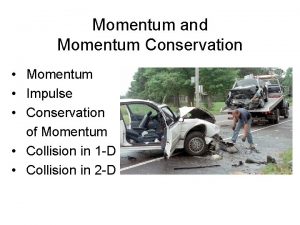Chapter 6 Section 1 Momentum and Impulse Momentum
































- Slides: 32

Chapter 6 Section 1 Momentum and Impulse Momentum refers to the quantity of motion that an object has. All objects have mass; so if an object is moving, then it has momentum - it is mass in motion. The amount of momentum which an object has is dependent upon two variables: how much stuff is moving and how fast the stuff is moving. Momentum is the power residing in a moving object

Momentum = mass • velocity p=m • v Momentum is directly proportional to an object's mass and directly proportional to the object's velocity. What does this mean? The more mass something has the more difficult it is to stop. This is because it has a certain momentum. The greater the momentum the longer the stopping time. Similarly, the greater the velocity an object has the greater the momentum of the object.

Momentum is a vector quantity, meaning it has a magnitude and a direction…but no worries … the direction is in the same direction as the velocity. Imagine you are riding a bike down a hill without applying the brakes. Because of the force of gravity, you are picking up speed…accelerating…your velocity is increasing, therefore your momentum is also increasing. The faster you move, the more momentum you have and the longer it will take you to stop.

Try these: You’re in an 800 kg race car going 90 m/s due east. If you have a mass of 60 kg, what is your momentum? You’re running north at 3. 0 m/s and have a mass of 80. 0 kg, what is your momentum? 77400 kg*m/s east 240 kg-m/s north

A car possesses 20 000 units of momentum. What would be the car's new momentum if. . . a. its velocity were doubled. b. its velocity were tripled. c. its mass were doubled (by adding more passengers and a greater load) d. both its velocity were doubled and its mass were doubled. A. p = 40 000 units (doubling the velocity will double the momentum) B. p = 60 000 units (tripling the velocity will triple the momentum) C. p = 40 000 units (doubling the mass will double the momentum) D. p = 80 000 units (doubling the velocity will double the momentum and doubling the mass will also double the momentum; the combined result is that the momentum is doubled twice -quadrupled)

In a collision, an object experiences a force for a specific amount of time which results in a change in momentum. The result of the force acting for the given amount of time is that the object's mass either speeds up or slows down (or changes direction). The impulse experienced by the object equals the change in momentum of the object. Impulse tells you how much the momentum of an object will change when a force is applied for a certain amount of time. Impulse = Change in momentum = ∆p

The Impulse-Momentum Theorem F∆t = ∆p or F∆t = mvf – mvi = ∆p A force acting for a given amount of time will change an object's momentum. An unbalanced force always accelerates an object - either speeding it up or slowing it down. A force applied opposite the object’s motion will slow it down and a force applied in the direction of the motion speeds it up. Keep these three things in mind: the impulse experienced by an object is the force • time the momentum change of an object is the mass • velocity change the impulse equals the momentum change

Try this: You are playing pool and hit a 200 g ball for 5 ms to give it a speed of 20. 0 m/s. What impulse does the ball have? What force did you apply to the pool ball? mvf – mvi = ∆p 0. 200 (20) – 0 = 4 kg m/s F∆t = ∆p F = 4 kgm/. 005 s = 800. 0 N

Home fun Pg 209 q 1 -3 Pg 211 q 1 -4

Stopping time and distance depend on the impulse-momentum theorem. If you've ever driven a car, you know that the faster you're going, the more room you need to slow down. Experts recommend that you leave a minimum of one car length between you and the car ahead of you for every 10 miles per hour that you are traveling. If your car is heavily loaded, it may take an even longer distance to stop. Which stops more quickly - a lighter car traveling at high speed, or a more massive car traveling more slowly?

Try this: A 0. 15 kg baseball moving at +26 m/s is slowed to a stop by a catcher who exerts a constant force of -390 N. How long does it take this force to stop the ball? How far does the ball travel before it stops? F∆t = ∆p rearrange ∆t = ∆p/F ∆p = mvf-mvi ∆t = mvf-mvi /F = 0. 15(26)/390 = 0. 01 s ∆x = ½(vi+vf) ∆t = ½(26)(0. 01) = 0. 13 m

Jennifer, who has a mass of 50. 0 kg, is riding at 25 m/s in her red sports car when she must suddenly slam on the brakes to avoid hitting a deer crossing the road. The seat belt engages and she strikes the air bag, which brings her body to a stop in 0. 500 s. What average forces do the seat belt and airbag exert on her? F = (mass * velocity change)/time F = (50 * 25) / 0. 500 F = 2500 N

If Jennifer had not been wearing her seat belt and not had an air bag, then the windshield would have stopped her head in 0. 002 s. What average force would the windshield have exerted on her? A hockey player applies an average force of 80. 0 N to a 0. 25 kg hockey puck for a time of 0. 10 seconds. Determine the impulse experienced by the hockey puck. F = (mass * velocity change)/time F = (50 * 25)/0. 002 F = 625 000 N seatbelts save lives Impulse = F*t = 80 N * 0. 1 s Impulse = 8 kg m/s

The greater the time over which the collision occurs, the smaller the force acting upon the object. To minimize the effect of the force on an object involved in a collision, the time must be increased. To maximize the effect of the force on an object involved in a collision, the time must be decreased.

The advent of air bags in automobiles is the single most important improvement to injury prevention for people in accidents after the seat belt. Both of these devices increase the time your body gets to stop during a collision. The use of our own legs as we jump down a given distance is another example of this effect. If you were to drop stiff legged with locked knees and spine held ridged, the falling distance that will cause serious injury moves from close to ten feet to just about an inch.

Home fun Pg 213 q 1 -3 Pg 214 q 1 -4 Quiz over section 1 in 2 days!!

Ch 6 -section 2 Conservation of Momentum For a collision occurring between object 1 and object 2 in an isolated system (no external forces), the total momentum of the objects before the collision is equal to the total momentum of the objects after the collision. That is, the momentum lost by object 1 is equal to the momentum gained by object 2.

Consider a collision between two cars, in a closed system. During the collision, the average force exerted on the first car by the second car is F 1. So for the first car : F 1∆t = ∆p 1 = m 1 ∆v 1 = m 1(vf 1 – vi 1) The average force exerted on the second car by the first car is F 2. So for the second car : F 2∆t = ∆p 2 = m 2 ∆v 2= m 2 (vf 2 – vi 2) F 1∆t + F 2∆t = ∆p 1 + ∆p 2 = m 1 ∆v 1 + m 2 ∆v 2 = m 1(vf 1 – vi 1) + m 2 (vf 2 – vi 2)

rearrange the equation to find : F 1∆t + F 2∆t = (m 1 vf 1 + m 2 vf 2) - (m 1 vi 1 + m 2 vi 2) = ∆pf ∆pi Add the forces together : ∑F ∆t = ∆pf - ∆pi = 0 Since we are working in a closed system we know that Newton’s third law (for every action there is an equal and opposite reaction) is in effect and the sum of the forces equals zero. So said another way: m 1 v 1 i + m 2 v 2 i = m 1 v 1 f + m 2 v 2 f

Try this: A pool ball with a mass m 1 v 1 i + m 2 v 2 i = m 1 v 1 f + m 2 v 2 f of 400 g and a speed of 0. 400 kg(30 m/s) + 0 = 0. 400 kg(10 m/s) + 0. 400 kg(v 30 m/s hits another pool ball that is at rest. The rearrange: first pool ball ends up v 2 f = 0. 400 kg(30 m/s) - 0. 400 kg(10 m/s) going in the same 0. 400 kg direction with a speed of 10 m/s. What is the v 2 f = 20 m/s velocity of the second pool ball? 2 f)

You’re stopped at a traffic light when a 1000 kg car (including driver) hits you from behind at 40. 0 m/s. If the other car ends up moving at 12 m/s and if you and your car have a mass of 940 kg, what is your final speed? 29. 8 30 m/s

Home fun Pg 219 q 1 -4 Pg 221 q 1 -4

When Worlds Collide: Elastic and Inelastic Collisions An inelastic collision is one in which part of the kinetic energy is changed to some other form of energy in the collision. An elastic collision is defined as one in which there is no loss of kinetic energy in the collision.

Perfectly Inelastic Collisions Occurs when two objects collide and move together as one single object. The final mass is equal to the combined mass of both objects after the collision. m 1 v 1 i + m 2 v 2 i = (m 1 +m 2) vf Try this: An empty train car moving east at 21 m/s collides with a loaded train car initially at rest that has twice the mass of the empty car. The two cars stick together. a) Find the velocity of the two cars after the collision. b) Find the final speed if the loaded car moving at 17. 0 m/s hits the empty car initially at rest. a. 7. 0 m/s east b. 11 m/s

Inelastic Collisions Objects deform and move separately after the collision. Kinetic Energy is NOT constant in inelastic collisions. Some energy is converted to sound energy and some energy goes to the deforming of the materials. Not all of the KE is lost in an inelastic collision.

Finding the Change in KE ΔKE = KEf –KEi = 1/2 m 1 v 1 i 2 + 1/2 m 2 v 2 i 2 KEf = KE 1 f + KE 2 f = ½ (m 1 + m 2) vf 2 Try This: A clay ball with a mass of 0. 35 kg hits another 0. 35 kg ball at rest and the two stick together. The first ball has an initial speed of 4. 2 m/s. What is the final speed of the balls? Calculate the decrease in KE that occurs What percentage of the KE is converted during the collision? 2. 1 m/s 1. 6 J 52%

Do these now: Pg 224 q 1 -5 Pg 226 q 1 -3

Elastic Collisions The most basic way to look at elastic collisions is to examine how the collisions work along a straight line. Objects in as elastic collision DO NOT stick together. Think about bumper cars at the amusement park. You are driving a 300 kg car at 10 m/s when the person in front of you, driving a 400 kg car, comes to a stop. What is the final velocity for both cars? Rut ro…two unknowns…what will we do?

Kinetic Energy is Conserved in Elastic Collisions ½ m 1 v 1 f 2 + ½ m 2 v 2 f 2 = 1/2 m 1 v 1 i 2 + 1/2 m 2 v 1 i 2 �= 0 m 1 v 1 f + m 2 v 2 f = m 1 v 1 i + m 2 v 2 i �= 0 rearrange to find: v 1 f = [(m 1 – m 2) v 1 i ] / (m 1+m 2) v 2 f = 2 m 1 v 1 i / (m 1+m 2) Use ONLY when v 2 i = 0 Back to the bumper cars: 300 kg car at 10 m/s and a 400 kg car, at rest. v 1 = -1. 43 m/s v 2 = 8. 57 m/s

When both objects have an initial velocity v 1 f = m 1 − m 2 (v 1 i ) m 1 + m 2 + 2 m 2 (v 2 i) m 1 + m 2 v 2 f = m 2 − m 1 ( v 2 i) + 2 m 1 (v 1 i) m 1 + m 2

Try these: You’re driving a bumper car at 23 m/s and hit another car that’s at rest. You and your car have a mass of 300 kg and the other has a mass of 240 kg. What are the final velocities of the two cars? Two non-rotating balls on a frictionless surface collide elastically head on. The first ball has a mass of 15 g and an initial velocity of 3. 5 m/s right. The second ball has a mass of 22 g and an initial velocity of 4. 0 m/s left. The final velocity of the 15 g ball is 5. 4 m/s left. What is the final velocity of the second (22 g) ball? 1. you 2. 6 m/s other car 26 m/s 2. 2. 0 m/s right

HOME PHUN Packet 6
 Physics 03-01 work and the work-energy theorem
Physics 03-01 work and the work-energy theorem Unit 6 momentum and impulse
Unit 6 momentum and impulse Unit of momentum and impulse
Unit of momentum and impulse How to find initial momentum
How to find initial momentum Linear impulse momentum equation
Linear impulse momentum equation Principle of linear impulse and momentum
Principle of linear impulse and momentum Importance of momentum
Importance of momentum Poem about momentum and impulse
Poem about momentum and impulse Impulse and momentum relationship
Impulse and momentum relationship Importance of momentum and impulse
Importance of momentum and impulse Momentum and impulse formula sheet
Momentum and impulse formula sheet Unit for momentum
Unit for momentum Impulse and momentum in sports
Impulse and momentum in sports Whats the definition of momentum
Whats the definition of momentum Momentum and impulse physics 30
Momentum and impulse physics 30 The momentum of an object at rest
The momentum of an object at rest Mel physics
Mel physics Define linear momentum and impulse
Define linear momentum and impulse What has momentum
What has momentum Units of impulse
Units of impulse Ap physics momentum and impulse
Ap physics momentum and impulse The drawing shows a collision between two pucks
The drawing shows a collision between two pucks Kinetics of a particle: impulse and momentum
Kinetics of a particle: impulse and momentum Unit 5 momentum 5.a center of mass
Unit 5 momentum 5.a center of mass Dynamics impulse and momentum solved problems
Dynamics impulse and momentum solved problems Principle of angular impulse and momentum
Principle of angular impulse and momentum Ap physics momentum and impulse
Ap physics momentum and impulse Further mechanics 1 unit test 1 momentum and impulse
Further mechanics 1 unit test 1 momentum and impulse Types of collision
Types of collision Impulse
Impulse Momentum in terms of energy
Momentum in terms of energy How does impulse relate to momentum
How does impulse relate to momentum The impulse-momentum relationship is a direct result of
The impulse-momentum relationship is a direct result of

